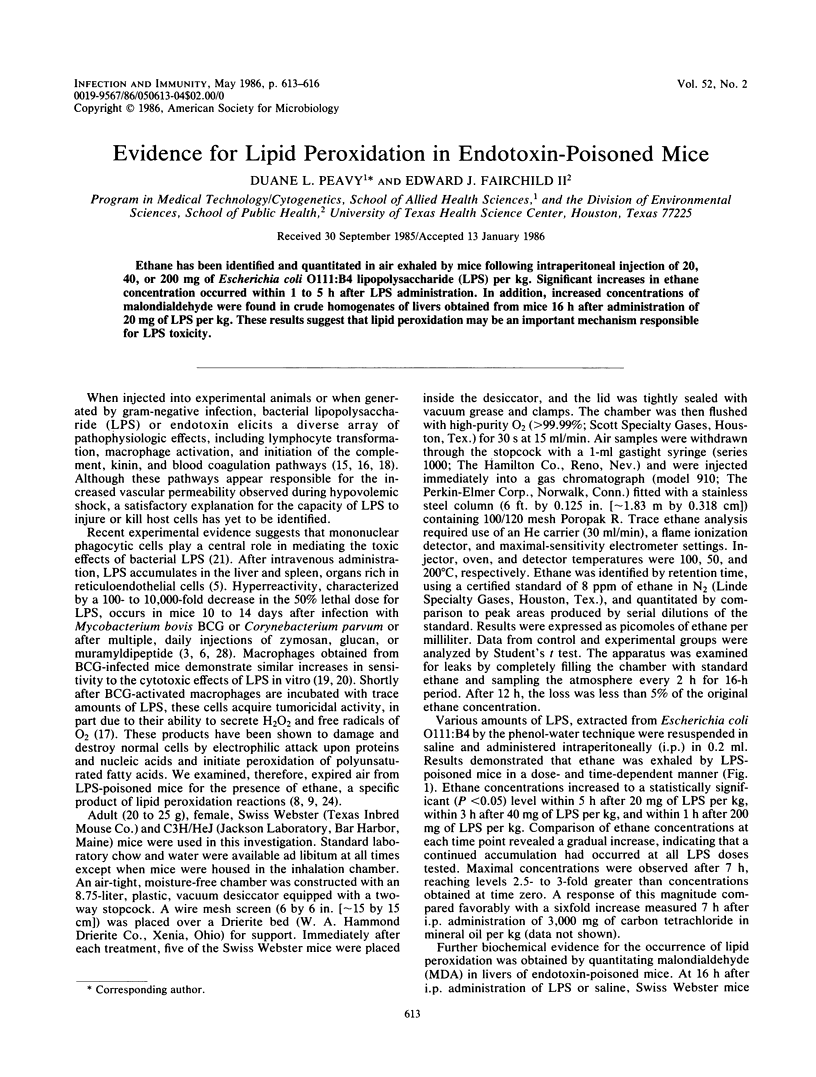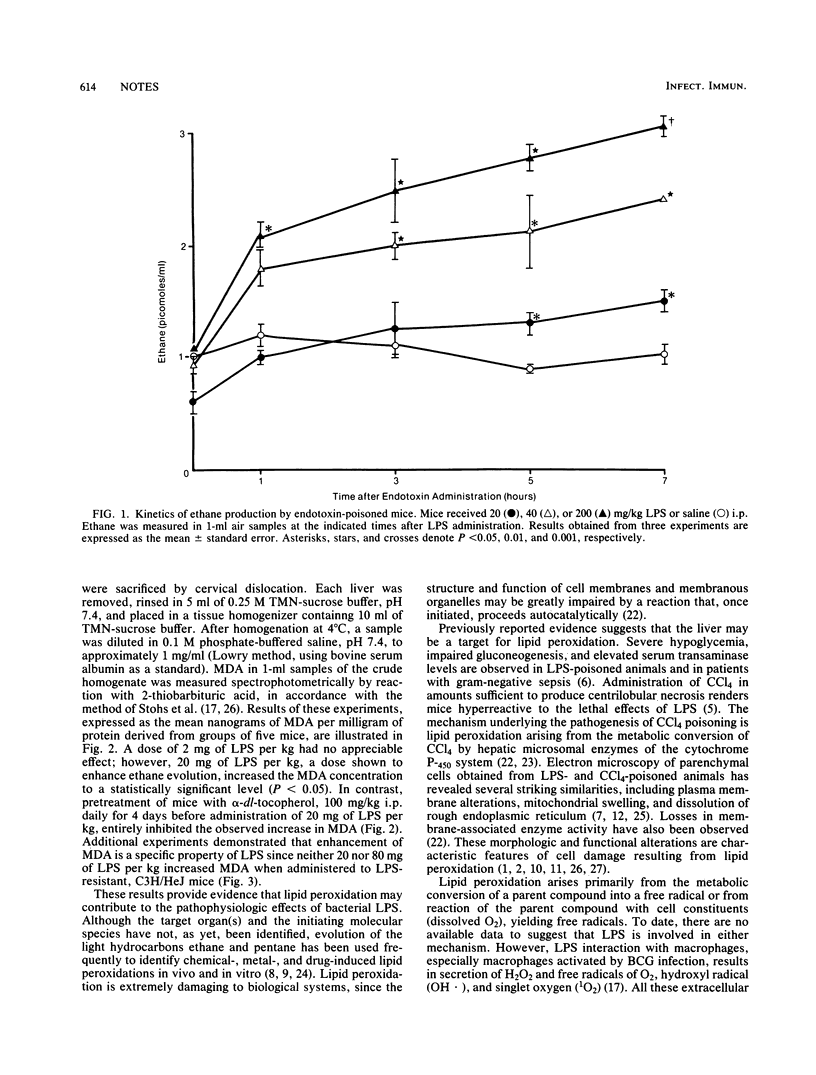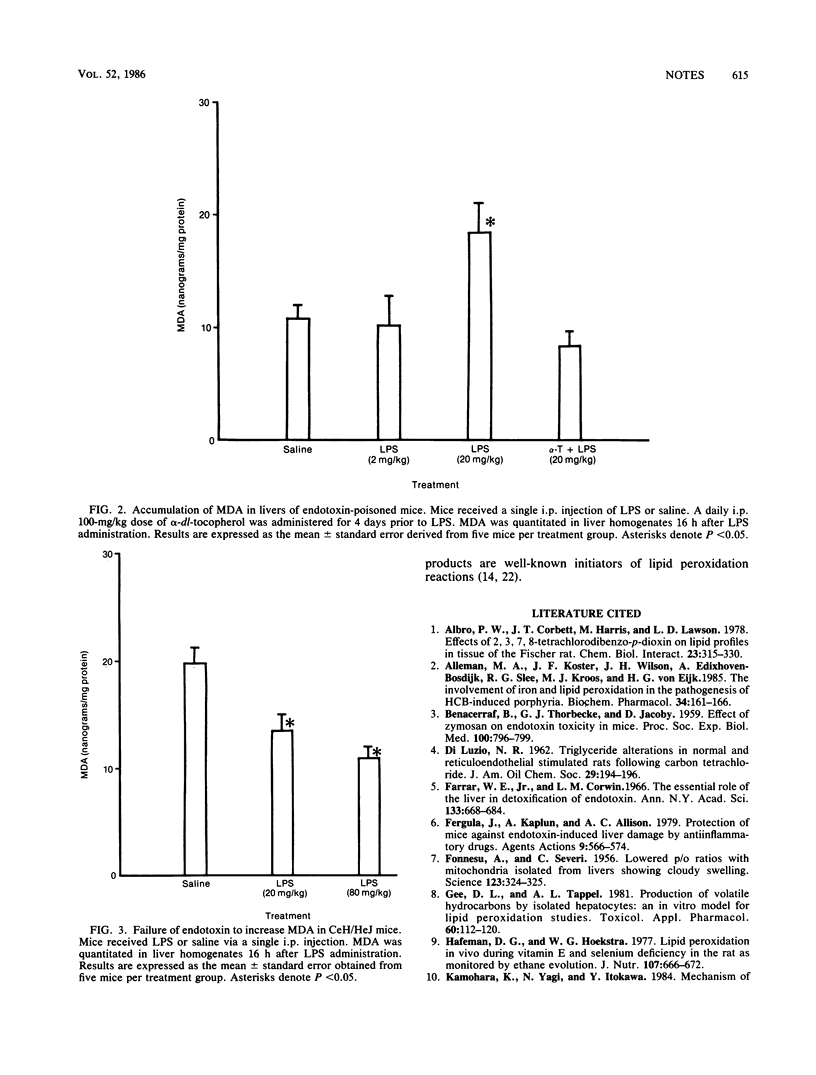Abstract
Ethane has been identified and quantitated in air exhaled by mice following intraperitoneal injection of 20, 40, or 200 mg of Escherichia coli O111:B4 lipopolysaccharide (LPS) per kg. Significant increases in ethane concentration occurred within 1 to 5 h after LPS administration. In addition, increased concentrations of malondialdehyde were found in crude homogenates of livers obtained from mice 16 h after administration of 20 mg of LPS per kg. These results suggest that lipid peroxidation may be an important mechanism responsible for LPS toxicity.
Full text
PDF



Selected References
These references are in PubMed. This may not be the complete list of references from this article.
- Albro P. W., Corbett J. T., Harris M., Lawson L. D. Effects of 2,3,7,8-tetrachlorodibenzo-p-dioxin on lipid profiles in tissue of the Fischer rat. Chem Biol Interact. 1978 Dec;23(3):315–330. doi: 10.1016/0009-2797(78)90093-5. [DOI] [PubMed] [Google Scholar]
- Alleman M. A., Koster J. F., Wilson J. H., Edixhoven-Bosdijk A., Slee R. G., Kroos M. J., von Eijk H. G. The involvement of iron and lipid peroxidation in the pathogenesis of HCB induced porphyria. Biochem Pharmacol. 1985 Jan 15;34(2):161–166. doi: 10.1016/0006-2952(85)90118-2. [DOI] [PubMed] [Google Scholar]
- BENACERRAF B., THORBECKE G. J., JACOBY D. Effect of zymosan on endotoxin toxicity in mice. Proc Soc Exp Biol Med. 1959 Apr;100(4):796–799. doi: 10.3181/00379727-100-24781. [DOI] [PubMed] [Google Scholar]
- FONNESU A., SEVERI C. Lowered P/O ratios with mitochondria isolated from livers showing cloudy swelling. Science. 1956 Feb 24;123(3191):324–324. doi: 10.1126/science.123.3191.324. [DOI] [PubMed] [Google Scholar]
- Farrar W. E., Jr, Corwin L. M. The essential role of the liver in detoxification of endotoxin. Ann N Y Acad Sci. 1966 Jun 30;133(2):668–684. doi: 10.1111/j.1749-6632.1966.tb52397.x. [DOI] [PubMed] [Google Scholar]
- Ferluga J., Kaplun A., Allison A. C. Protection of mice against endotoxin-induced liver damage by anti-inflammatory drugs. Agents Actions. 1979 Dec;9(5-6):566–574. doi: 10.1007/BF01968129. [DOI] [PubMed] [Google Scholar]
- Gee D. L., Tappel A. L. Production of volatile hydrocarbons by isolated hepatocytes: an in vitro model for lipid peroxidation studies. Toxicol Appl Pharmacol. 1981 Aug;60(1):112–120. doi: 10.1016/0041-008x(81)90141-1. [DOI] [PubMed] [Google Scholar]
- Hafeman D. G., Hoekstra W. G. Lipid peroxidation in vivo during vitamin E and selenium deficiency in the rat as monitored by ethane evolution. J Nutr. 1977 Apr;107(4):666–672. doi: 10.1093/jn/107.4.666. [DOI] [PubMed] [Google Scholar]
- Kamohara K., Yagi N., Itokawa Y. Mechanism of lipid peroxide formation in polychlorinated biphenyls (PCB) and dichlorodiphenyltrichloroethane (DDT)-poisoned rats. Environ Res. 1984 Jun;34(1):18–23. doi: 10.1016/0013-9351(84)90071-9. [DOI] [PubMed] [Google Scholar]
- Kato N., Kawai K., Yoshida A. Effect of dietary level of ascorbic acid on the growth, hepatic lipid peroxidation, and serum lipids in guinea pigs fed polychlorinated biphenyls. J Nutr. 1981 Oct;111(10):1727–1733. doi: 10.1093/jn/111.10.1727. [DOI] [PubMed] [Google Scholar]
- Levy E., Slusser R. J., Ruebner B. H. Hepatic changes produced by a single dose of endotoxin in the mouse. Electron microscopy. Am J Pathol. 1968 Feb;52(2):477–502. [PMC free article] [PubMed] [Google Scholar]
- Loose L. D., Silkworth J. B., Pittman K. A., Benitz K. F., Mueller W. Impaired host resistance to endotoxin and malaria in polychlorinated biphenyl- and hexachlorobenzene-treated mice. Infect Immun. 1978 Apr;20(1):30–35. doi: 10.1128/iai.20.1.30-35.1978. [DOI] [PMC free article] [PubMed] [Google Scholar]
- Morrison D. C., Ryan J. L. Bacterial endotoxins and host immune responses. Adv Immunol. 1979;28:293–450. doi: 10.1016/s0065-2776(08)60802-0. [DOI] [PubMed] [Google Scholar]
- Morrison D. C., Ulevitch R. J. The effects of bacterial endotoxins on host mediation systems. A review. Am J Pathol. 1978 Nov;93(2):526–618. [PMC free article] [PubMed] [Google Scholar]
- Nathan C. F. Secretion of oxygen intermediates: role in effector functions of activated macrophages. Fed Proc. 1982 Apr;41(6):2206–2211. [PubMed] [Google Scholar]
- Peavy D. L., Baughn R. E., Musher D. M. Mitogenic activity of bacterial lipopolysaccharides in vivo: morphological and functinal characterization of responding cells. Infect Immun. 1978 Jan;19(1):71–78. doi: 10.1128/iai.19.1.71-78.1978. [DOI] [PMC free article] [PubMed] [Google Scholar]
- Peavy D. L., Baughn R. E., Musher D. M., Musher D. M. Effects of BCG infection on the susceptibility of mouse macrophages to endotoxin. Infect Immun. 1979 Apr;24(1):59–64. doi: 10.1128/iai.24.1.59-64.1979. [DOI] [PMC free article] [PubMed] [Google Scholar]
- Peavy D. L., Baughn R. E., Musher D. M. Strain-dependent cytotoxic effects of endotoxin for mouse peritoneal macrophages. Infect Immun. 1978 Jul;21(1):310–319. doi: 10.1128/iai.21.1.310-319.1978. [DOI] [PMC free article] [PubMed] [Google Scholar]
- REYNOLDS E. S. LIVER PARENCHYMAL CELL INJURY. I. INITIAL ALTERATIONS OF THE CELL FOLLOWING POISONING WITH CARBON TETRACHLORIDE. J Cell Biol. 1963 Oct;19:139–157. doi: 10.1083/jcb.19.1.139. [DOI] [PMC free article] [PubMed] [Google Scholar]
- Riely C. A., Cohen G., Lieberman M. Ethane evolution: a new index of lipid peroxidation. Science. 1974 Jan 18;183(4121):208–210. doi: 10.1126/science.183.4121.208. [DOI] [PubMed] [Google Scholar]
- Stewart G. J. Effect of endotoxin on the ultrastructure of liver and blood cells of hamsters. Br J Exp Pathol. 1970 Apr;51(2):114–117. [PMC free article] [PubMed] [Google Scholar]
- Stohs S. J., Hassan M. Q., Murray W. J. Effects of BHA, d-alpha-tocopherol and retinol acetate on TCDD-mediated changes in lipid peroxidation, glutathione peroxidase activity and survival. Xenobiotica. 1984 Jul;14(7):533–537. doi: 10.3109/00498258409151443. [DOI] [PubMed] [Google Scholar]
- Stohs S. J., Hassan M. Q., Murray W. J. Lipid peroxidation as a possible cause of TCDD toxicity. Biochem Biophys Res Commun. 1983 Mar 29;111(3):854–859. doi: 10.1016/0006-291x(83)91377-3. [DOI] [PubMed] [Google Scholar]
- Vos J. G., Kreeftenberg J. G., Engel H. W., Minderhoud A., Van Noorle Jansen L. M. Studies on 2,3,7,8-tetrachlorodibenzo-p-dioxin induced immune suppression and decreased resistance to infection: endotoxin hypersensitivity, serum zinc concentrations and effect of thymosin treatment. Toxicology. 1978 Feb;9(1-2):75–86. doi: 10.1016/0300-483x(78)90033-1. [DOI] [PubMed] [Google Scholar]


